A Trip Into Psychedelic History
Through the Archive of Myron Stolaroff
Jun 2009
Citation: Hanna J. "A Trip Into Psychedelic History: Through the Archive of Myron Stolaroff." Erowid Extracts. Jun 2009;16:4-7.
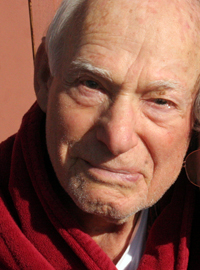
Photo by Jon Hanna |
Two vans transported Sasha and Ann, their assistant Tania, a long-time friend, me, and coolers full of wine and food. We were off to spend time with a couple of psychedelic pioneers: Myron and Jean Stolaroff. While the Shulgins said it had been only a few years for them, it had been twelve years since I'd last made my way to the incredibly surreal landscape near the Alabama Hills of California where the Stolaroffs live. Comprised of ninety-million-year-old rounded granite boulders and red-orange volcanic rock, the Alabama Hills look like ancient entities guarding an otherwise deserted landscape. Spring wildflowers were just starting to bloom. Nearby, a drying-up lakebed glowed with a white band of salt. Snow-capped mountains loomed surprisingly close, topping off an environment of mystical extremes.
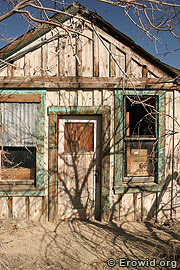
Photo by Jon Hanna |
An engineer by training, Myron was a fastidious record keeper. Not only were the letters he had received from research colleagues all saved and filed (including quite a number of missives between others that had been forwarded to him), but there were also carbon copies of what he had written to others tucked in beside these. He even went so far as to print out his sent and received emails! Communications regarding psychedelics stretched back as far as the late 1950s. A bounty of correspondence relates the inner workings of Myron's International Foundation for Advanced Study (IFAS) in Menlo Park, where, in the early 1960s, carbogen, LSD, and mescaline were given to hundreds of subjects, and studies into the effect of psychedelics on creative problem solving showed great promise.
One of the first boxes of materials that we began to read through was a series of letters between Myron and his main compatriot in the IFAS project: the mysterious and controversial Al Hubbard. Considered by many to be the "Johnny Appleseed of LSD", Hubbard was infamous for jet-setting around the world to introduce people to LSD, and known for his promotion of carbogen as a pre-psychedelic "fitness test". The communications between Myron and Al, as well as their letters to others working with psychedelics, present a chronology of initial enthusiasm, struggles for legitimacy, and eventual disappointments.
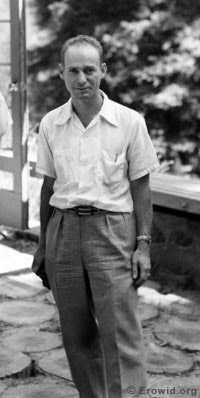
Stolaroff Collection © 2009 |
Questions...
Surprisingly, even early on, concerns about the purity of their chemicals surfaced: "We are now using some of the most recent stuff that we last received. When you open the ampoules, a white precipitate forms, which makes it very difficult to extract with a syringe. I hope there is nothing wrong with the material" [Myron to Al and Rita Hubbard, October 10, 1961]....and Conflicts
Over time, conflicts between assorted personalities in the scene began to appear in communications: "[Michael Hollingshead] is thoroughly dishonest, and a most convincing liar" [Al Hubbard to Humphry Osmond, February 19, 1963].Differences in approach are highlighted in a February 28, 1963 letter, wherein Myron thanks Timothy Leary for his hospitality during a visit, and for the use of Dick Alpert's "excellent bed," before castigating Leary for the approach that he planned to take with his International Federation for Internal Freedom (IFIF). Many have, in retrospect, bemoaned that Leary's actions brought an end to the above-ground study of psychedelics. Myron's comments, however, hit this target before scandal erupted at Harvard:
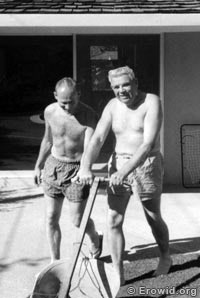
Stolaroff Collection © 2009 |
Having had a chance to more carefully gather my thoughts...I thought it best to dash them off to you, so as to leave no doubt whatever as to my position. Not that I have any ideas that this will accomplish anything, as I am convinced that you will go ahead and proceed with your program regardless of what anyone else thinks.The letter continues in a similar vein. In just over two months from the time Myron wrote those words, Leary was fired from Harvard for failing to keep his classroom appointments. Later, a June 6, 1963 letter from Humphry Osmond to Al Hubbard remarks:
I already told you when I saw you that I thought the moves you were contemplating with IFIF are insane, and would wreak tremendous havoc on all of us doing LSD work all over the nation. Now after a few days of reviewing the data in my own mind, and weighing out the relative consequences of various moves, I wonder how you ever got any data anywhere that would indicate any possibility of success?
My concern that you [should] inform Leary is to ensure that he gets every opportunity not to use his dud LSD25. I doubt whether he will take any notice of you or me, but he must have the chance & those around him may at least hear, & someone might avoid a nasty accident. By telling him[,] it will be clear that you have given him every chance to stop. This might be important at a later date. Aldous [Huxley] tells me that he has passed on the content of my letter. (to Tim Leary) He is going to inform anyone he comes across to steer clear. The result of some of these dud substances used by inept people can be so serious that even if only one such misfortune is avoided it will be worthwhile. Leary's mail order drug scene suggests the very poorest judgement & can only do harm.
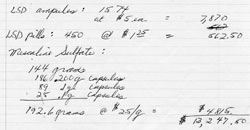
Stolaroff Collection © 2009 |
...we knew that the black market material was indeed questionable, and [Alan] Watts was using it and giving it to others. Now in my opinion he is no more worthy of consideration than anyone else.
Black Market LSD Prices
A later letter, from Hubbard to Albert Hofmann, informs LSD's inventor of the diversion of some Sandoz material that had been sent to the researcher John Beresford. A portion of the 20 grams of acid that Beresford purchased was later sold into the black market at a price of $70,000 per gram. Around that time, IFAS was paying $5 each for ampoules containing 0.1 mg in 1 ml of solution (or $50,000 per gram).

Stolaroff Collection © 2009 |
Hubbard Jumps Ship
In February of 1965, Al Hubbard submitted his resignation from his position as consultant to IFAS--largely due to personality conflicts with IFAS's medical doctor, Charles Savage. Hubbard left the organization owing Myron nearly $100,000 (after Myron had already contributed over $200,000 toward Hubbard's work with LSD). Al owed others additional money as well. As time passed, bank notices to Myron about Al's outstanding debts started to trickle in, asking for help in obtaining the funds from Hubbard.Over time, conflicts between assorted personalities in the scene began to appear in communications...
As the 1960s drew to a close, legal restrictions worldwide put an end to research involving scheduled psychedelics. Eventually realizing that Hubbard had no intention of repaying what he owed, Myron assumed an $83,000 debt that Hubbard had borrowed from their mutual friend and project investor, Bob Morris. In doing so, Myron cut his ties with Al. In a final letter, dated December 3, 1975, Myron writes:
If you are wondering why in the world I would assume your rightful debt, the answer comes in recognizing the depth of repugnance I feel for having been so utterly gullible, and having been a party to some of the awful abominations that were perpetuated on other people. I hope to leave this plane with a clear conscience.
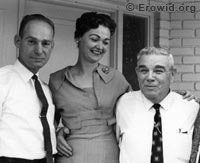
Stolaroff Collection © 2009 |
A Varied Collection
Along with some handwritten notes detailing how much money the IFAS spent on what quantity of which psychedelics, a few choice photographs were scattered among the letters and postcards: a handsome young Myron in a white shirt (see #3), a shot of Myron and Al Hubbard mowing a lawn (see #4), and some pictures with Al's wife Rita (see #5).
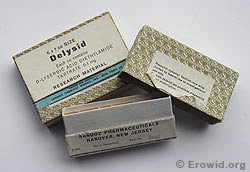
Photo by Jon Hanna |
Myron's collection includes a wide variety of materials: brochures, IRS filing information, organizational financial statements, book drafts, conference catalogs, off-prints of IFAS articles (and postcards requesting off-prints), assorted magazines (The Psychedelic Review, IONS Noetic Sciences Review, The Entheogen Review, to name a few), numerous books, and a box with reel-to-reel cans filled--at least in some cases--with recordings made during IFAS clients' psychedelic experiences. One exciting find was a couple of boxes that used to contain ampoules of Sandoz Delysid LSD (see #8). A more bulky artifact was Myron's old carbogen tank; only a trickle of gas remained (see #9). We came across several drafts of an unpublished fictional manuscript titled To Foil Armageddon that Myron wrote under the pseudonym Rudyard Abrams. And, Sasha got a laugh out of a condom slingshot stuffed in among the papers.
There's an immense amount of work left to do, to catalog, scan, and archive the Stolaroff Collection.
Bringing it Home
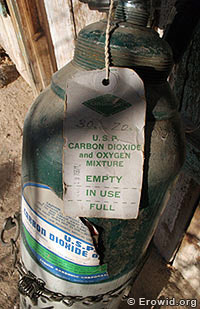
Photo by Jon Hanna |
A few days later at my house, Earth and Fire joined Tania and me to rough-sort the documents from the Stolaroff Collection, filling 14 plastic file boxes. Four additional file boxes were filled, marked for return to Myron and Jean after determining that the materials were either duplicates or not of interest. Erowid's shipping goddess, Bläk, then prepared a small "first batch" of items for scanning by placing the letters into chronological order, tagging each with a unique identifying number, and creating a catalog of short descriptions for each item.
There is an immense amount of work left to do, to catalog, scan, and archive the Stolaroff Collection. Erowid is seeking targeted donations to support this project so that we can make this fascinating slice of psychedelic history available to the public. If you would like to help, please see Erowid.org/donations/stolaroff. As the project continues, we will publish updates in future issues of Erowid Extracts.

